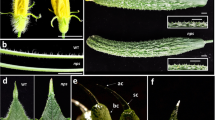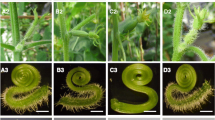Abstract
Key message
Using map-based cloning of Tril gene, we identified a homeodomain-leucine zipper gene involved in the initiation of multicellular trichomes (including the spines of fruit) in cucumber.
Abstract
Fruit spines are a special type of trichome that impacts the quality and appearance of cucumber (Cucumis sativus L.) fruit. Scanning electron microscopy revealed that the trichome-less (tril) mutant originating from European greenhouse cucumber has a completely glabrous phenotype on cotyledons, hypocotyls, young leaves, fruits, and fruit stalks. Genetic analysis revealed that tril was inherited as a recessive allele at a single locus. Using 1058 F2 individuals derived from a cross between cucumber tril mutant CGN19839 and the micro-trichome (mict) mutant 06-2, tril was mapped to chromosome 6, and narrowed down to a 37.4 kb genomic region which carries seven predicted genes. Genetic and molecular analyses revealed that gene Cucsa.045360 is a possible candidate gene for the differentiation of epidermal cells to trichomes. It is a member of the class IV homeodomain-leucine zipper (HD-Zip IV) family and encodes homeodomain and START domain, sharing 66.7 % predicted amino acid sequence identity to PROTODERMAL FACTOR2 (PDF2) and 35.0 % to GLABRA2 (GL2) of Arabidopsis. The homeobox domain had changed amino acid sequence because of an insertion in tril mutant. The results of genetic analysis and transcriptome profiling indicated that the Tril gene had an epistatic effect on the Mict gene in trichome development. Phenotypes of the tril mutant such as glabrous fruits and female flowers at every node could be used in developing new cultivars.







Similar content being viewed by others
References
Abe M, Katsumata H, Komeda Y, Takahashi T (2003) Regulation of shoot epidermal cell differentiation by a pair of homeodomain proteins in Arabidopsis. Development 130:635–643
Bennett RN, Wallsgrove RM (1994) Tansley review No. 72: secondary metabolites in plant defence mechanisms. New Phytol 127:617–633
Cavagnaro PF, Senalik DA, Yang L, Simon PW, Harkins TT, Kodira CD, Huang SW, Weng Y (2010) Genome-wide characterization of simple sequence repeats in cucumber (Cucumis sativus L.). BMC Genom 11:569
Choi YE, Harada E, Wada M, Tsuboi H, Morita Y, Kusano T, Sano H (2001) Detoxification of cadmium in tobacco plants: formation and active excretion of crystals containing cadmium and calcium through trichomes. Planta 213:45–50
Grebe M (2012) The patterning of epidermal hairs in Arabidopsis—updated. Curr Opin Plant Biol 15:31–37
Huang SW, Li RQ, Zhang ZH, Li L, Gu XF, Fan W (2009) The genome of the cucumber, Cucumis sativus L. Nat Genet 41:1275–1281
Ishida T, Kurata T, Okada K, Wada T (2008) A genetic regulatory network in the development of trichomes and root hairs. Annu Rev Plant Biol 59:365–386
Kirik V, Simon M, Wester K, Schiefelbein J, Hulskamp M (2004) ENHANCER of TRY and CPC2 (ETC2) reveals redundancy in the region-specific control of trichome development of Arabidopsis. Plant Mol Biol 55:389–398
Kirik V, Lee MM, Wester K, Herrmann U, Zheng Z, Oppenheimer D, Schiefelbein J, Hulskamp M (2005) Functional diversification of MYB23 and GL1 genes in trichome morphogenesis and initiation. Development 132:1477–1485
Küpper H, Lombi E, Zhao FJ, McGrath SP (2000) Cellular compartmentation of cadmium and zinc in relation to other elements in the hyperaccumulator Arabidopsis halleri. Planta 212:75–84
Lander E, Green P, Abrahamson J, Barlow A, Daley M, Lincoln S, Newburg L (1987) MAPMAKER: an interactive computer package for constructing primary genet ic linkage maps. Genomics 1:174–181
Li YH, Wen CL, Weng YQ (2013) Fine mapping of the pleiotropic locusBfor black spine and orange mature fruit color in cucumber identifies a 50 kb region containing a R2R3-MYB transcription factor. Theor Appl Genet 126:2187–2196
Li Q, Cao CX, Zhang CJ, Zheng SS, Wang ZH, Wang LN, Ren ZH (2015) The identification of Cucumis sativus Glabrous 1(CsGL1) required for the formation of trichomes uncovers a novel function for the homeodomain-leucine zipper I gene. J Exp Bot 66(9):2515–2526
Michelmore RW, Paran I, Kesseli RV (1991) Identification of markers linked to disease resistance genes by bulked segregant analysis: a rapid method to detect markers in specific genomic regions by using segregating populations. Proc Natl Acad Sci USA 88:9828–9832
Murray MG, Thompson WF (1980) Rapid isolation of high molecular-weight plant DNA. Nucleic Acids Res 8:4321–4325
Nakamura M, Katsumata H, Abe M, Yabe N, Komeda Y, Yamamoto KT (2006) Characterization of the class IV homeodomain-Leucine Zipper gene family in Arabidopsis. Plant Physiol 141:1363–1375
Payne CT, Zhang F, Lloyd AM (2000) GL3 encodes a bHLH protein that regulates trichome development in Arabidopsis through interaction with GL1 and TTG1. Genetics 156:1349–1362
Pesch M, Hülskamp M (2009) One, two, three…models for trichome patterning in Arabidopsis? Curr Opin Plant Biol 12:587–592
Rozen S, Skaletsky H (2000) Primer3 on the WWW for general users and for biologist programmers. Methods Mol Biol 132:365–386
Schiefelbein J (2003) Cell-fate specification in the epidermis: a common patterning mechanism in the root and shoot. Curr Opin Plant Biol 6:74–78
Schrick K, Nguyen D, Karlowski WM, Mayer KF (2004) START lipid/sterol-binding domains are amplified in plants and are predominantly associated with homeodomain transcription factors. Genome Biol 5:R41
Voorrips RE (2002) MapChart, software for the graphical presentation of linkage maps and QTLs. J Hered 93:77–78
Wagner GJ, Wang E, Shepherd RW (2004) New approaches for studying and exploiting an old protuberance, the plant trichome. Ann Bot 93:3–11
Walker AR, Davison PA, Bolognesi-Winfield AC, James CM, Srinivasan N, Blundell TL, Esch JJ, Marks MD, Gray JC (1999) The TRANSPARENT TESTA GLABRA1 locus, which regulates trichome differentiation and anthocyanin biosynthesis in Arabidopsis, encodes a WD40 repeat protein. Plant Cell 11:1337–1349
Wang SC, Barron C, Schiefelbein J, Chen JG (2010) Distinct relationship between GLABRA2 and single-repeat R3 MYB transcription factors in the regulation of trichome and root hair patterning in Arabidopsis. New Phytol 185:387–400
Werker E (2000) Trichome diversity and development. Adv Bot Res 31:1–35
Wester K, Digiuni S, Geier F, Timmer J, Fleck C, Hülskamp M (2009) Functional diversity of R3 single-repeat genes in trichome development. Development 136:1487–1496
Yang CX, Li HX, Zhang JH, Wang TT, Ye ZB (2011a) Fine-mapping of the woolly gene controlling multicellular trichome formation and embryonic development in tomato. Theor Appl Genet 123:625–633
Yang CX, Li HX, Zhang JH, Luo ZD, Gong PJ, Zhang CJ, Li JH, Wang TT, Zhang YY, Lu TE, Ye ZB (2011b) A regulatory gene induces trichome formation and embryo lethality in tomato. PNAS 108:11836–11841
Yang L, Koo DH, Li Y, Zhang X, Luan F, Havey MJ, Jiang J, Weng Y (2012) Chromosome rearrangements during domestication of cucumber as revealed from high-density genetic mapping and draft genome assembly. Plant J 71:895–906
Yuan XJ, Pan JS, Cai R, Guan Y, Liu LZ, Zhang WW, Li Z, Zhang He HL C, Si LT, Zhu LH (2008) Genetic mapping and QTL analysis of fruit and flower related traits in cucumber (Cucumis sativus L.). Euphytica 164:473–491
Zhang WW, Pan JS, He HL, Zhang C, Li Z, Zhao JL, Yuan XJ, Zhu LH, Huang SW, Cai R (2012) Construction of a high density integrated genetic map for cucumber (Cucumis sativus L.). Theor Appl Genet 124:249–259
Zhao JL, Pan JS, Guan Y, Zhang WW, Bie BB, Wang YL, He HL, Lian HL, Cai R (2015a) Micro-trichome as a class I homeodomain-leucine zipper gene regulates multicellular trichome development in Cucumis sativus. IOP Publishing NCBI. doi:10.1111/jipb.12345. http://www.ncbi.nlm.nih.gov/pubmed/25735194. Accessed 4 Mar 2015
Zhao JL, Wang YL, Yao DQ, Zhu WY, Chen L, He HL, Pan JS, Cai R (2015b) Transcriptome profiling of trichome-less reveals genes associated with multicellular trichome development in Cucumis sativus. Mol Genet Genomics 290:2007–2018
Acknowledgments
We thank Dr. Yi-qun Weng (Horticulture Department, University of Wisconsin-Madison, USA) for affording information of cucumber genetic map. This work was supported by grants from the National Natural Science Foundation of China (No. 31471156), China 973 Program (No. 2012CB113900), the Science and Technology Commission of Shanghai Municipality (No. 13JC1403600), the Shanghai Graduate Education and Innovation Program (Horticulture), the China Innovative Research Team, Ministry of Education.
Author information
Authors and Affiliations
Corresponding authors
Ethics declarations
Declaration
The experiments comply with the current laws of the country in which we were performed.
Conflict of interest
The authors declare that they have no conflict of interest.
Additional information
Communicated by M. J. Havey.
Electronic supplementary material
Below is the link to the electronic supplementary material.
122_2015_2628_MOESM1_ESM.doc
Fig. S1 The tril cucumber plants show other phenotype. Besides glabrous phenotype, the tril mutant plants show unbranched (a), gynoecious (b, upper red arrow), leaf curvature (b, lower red arrow), and petals opened 1-2 days before flowering (c). (DOC 6235 kb)
122_2015_2628_MOESM2_ESM.doc
Fig. S2 Amino-acids sequence of six predicted genes. A comparison of the tril mutant with non-glabrous type Gy14, 9930, and 06-2 plants. Shaded residues indicate strong conservation. There were no differences between the tril mutant and non-glabrous type plants in the deduced amino acid sequences of these six predicted genes, respectively. (a) Cucsa.045370. (b) Cucsa.045380. (c) Cucsa.045390. (d) Cucsa.045400. (e) Cucsa.045410. (f) Cucsa.045420. (DOC 83 kb)
122_2015_2628_MOESM3_ESM.doc
Fig. S3 Amino acid alignment of the predicted protein of Tril ( Cucsa.045360 ) with seven HD proteins from other species. The two conserved domains, an HD domain and a START domain, are represented by black lines. These two regions are highly conserved among their homologues. At: Arabidopsis thaliana, Cm: Cucumis melo, Cs: Cucumis sativus, Gh: Gossypium hirsutum, Ns: Nicotiana sylvestris, Rt: Populus trichocarpa, Rc: Ricinus communis, and Vv: Vitis vinifera. (DOC 85 kb)
122_2015_2628_MOESM4_ESM.doc
Fig. S4 Comparison of Cucsa.045360 gene structures in wild-type (a) and tril mutant (b). The predicted gene structure revealed that the Cucsa.045360 gene with an insertion should be separated to two transcripts in the tril mutant (b). The START domain still retained its original function in the tril mutant, while the homeobox domain was changed because of a fragment insertion. (DOC 69 kb)
122_2015_2628_MOESM5_ESM.doc
Fig. S5 Expression of Cucsa.045360 of wild-type 9930 and tril mutant using RT-PCR analyses. Polymorphism only appeared in the first part of the transcription between 9930 and tril mutant. M: Markers (DL10000). The sequences of primers used are given in Table S2. (DOC 32 kb)
Rights and permissions
About this article
Cite this article
Wang, YL., Nie, Jt., Chen, HM. et al. Identification and mapping of Tril, a homeodomain-leucine zipper gene involved in multicellular trichome initiation in Cucumis sativus . Theor Appl Genet 129, 305–316 (2016). https://doi.org/10.1007/s00122-015-2628-4
Received:
Accepted:
Published:
Issue Date:
DOI: https://doi.org/10.1007/s00122-015-2628-4




